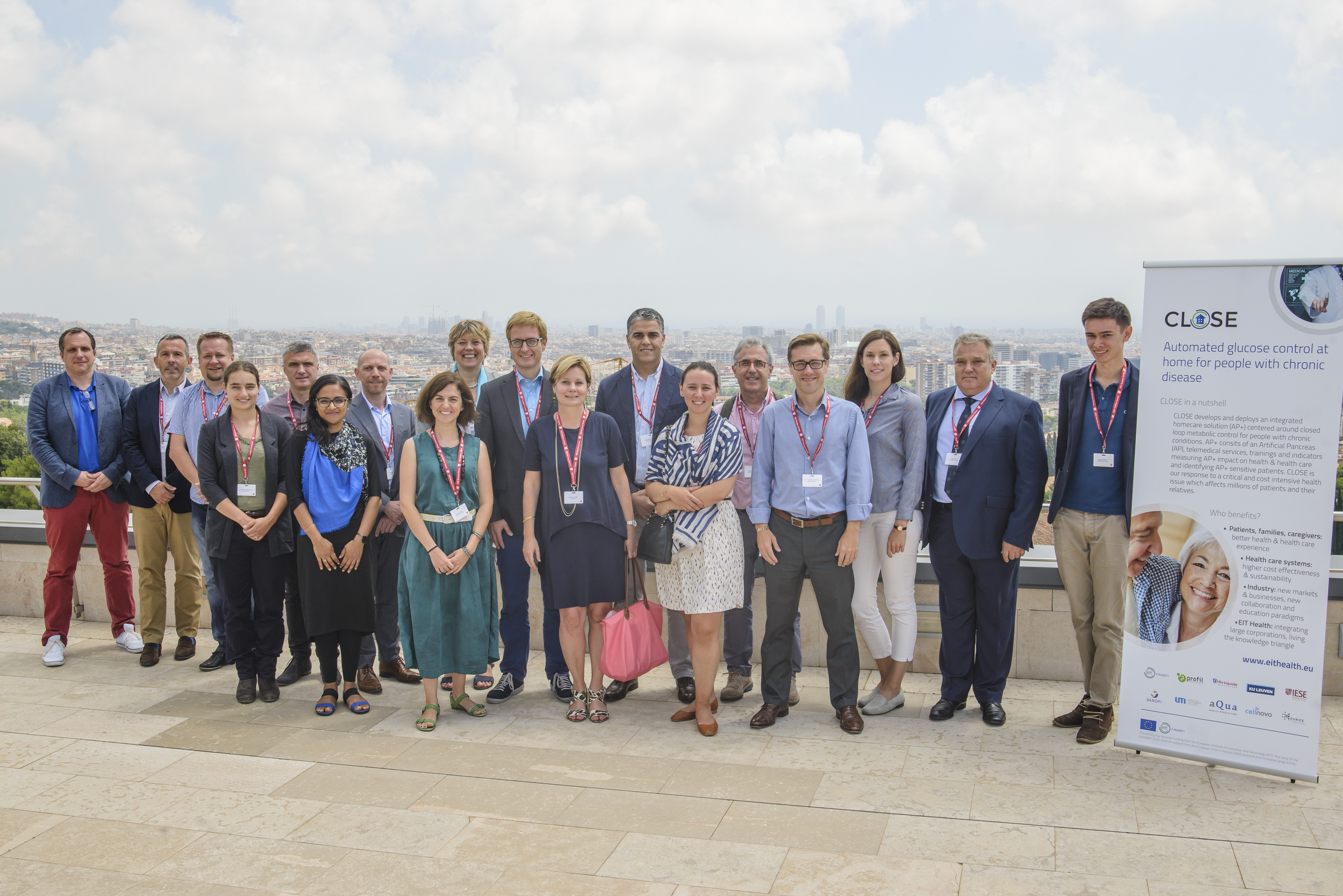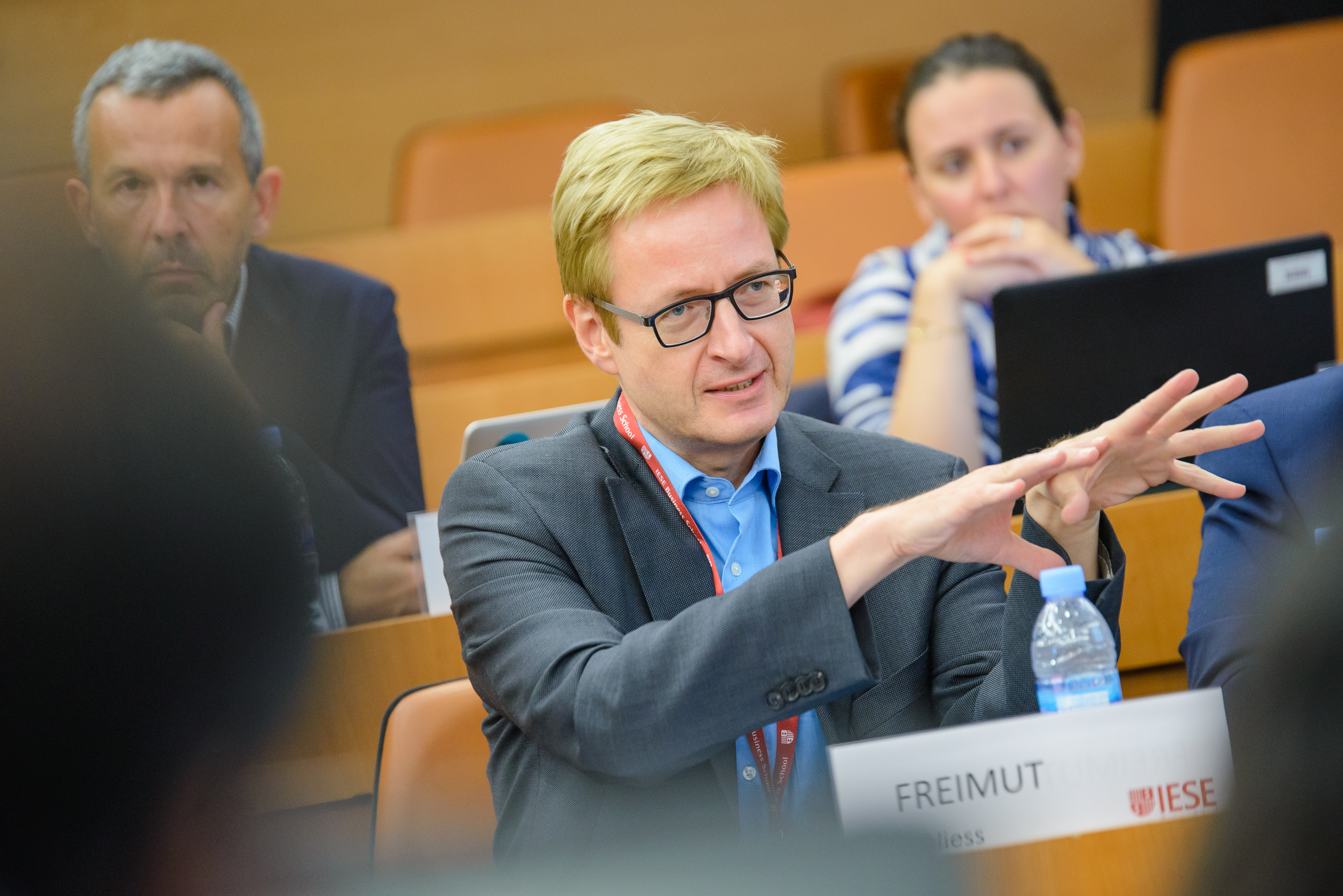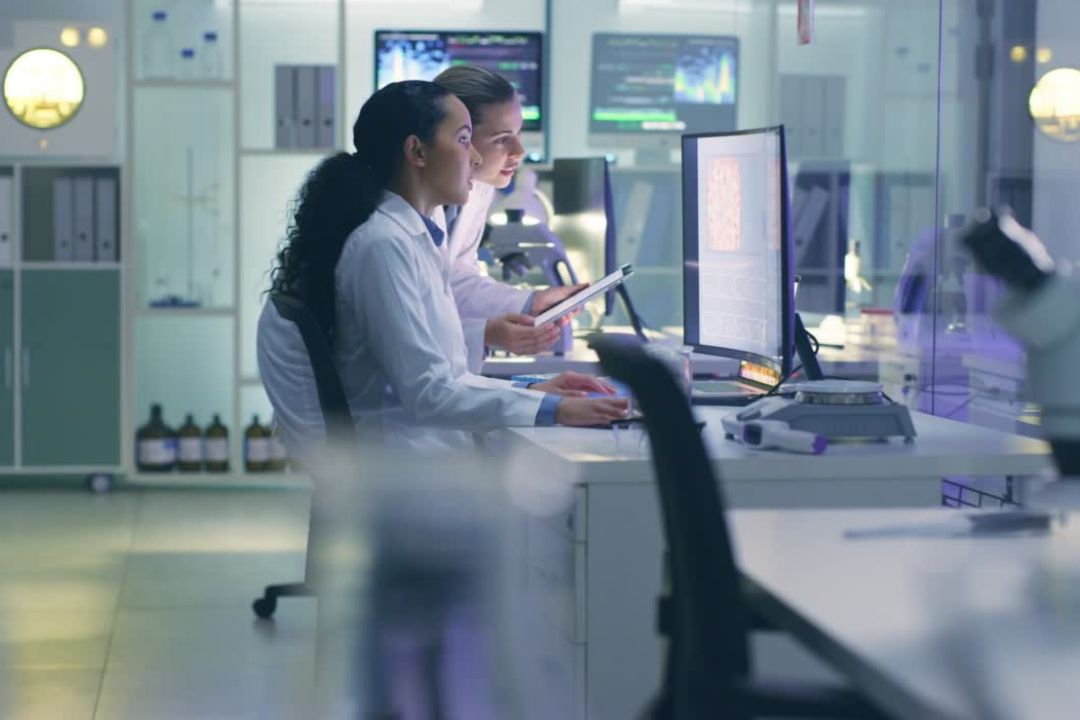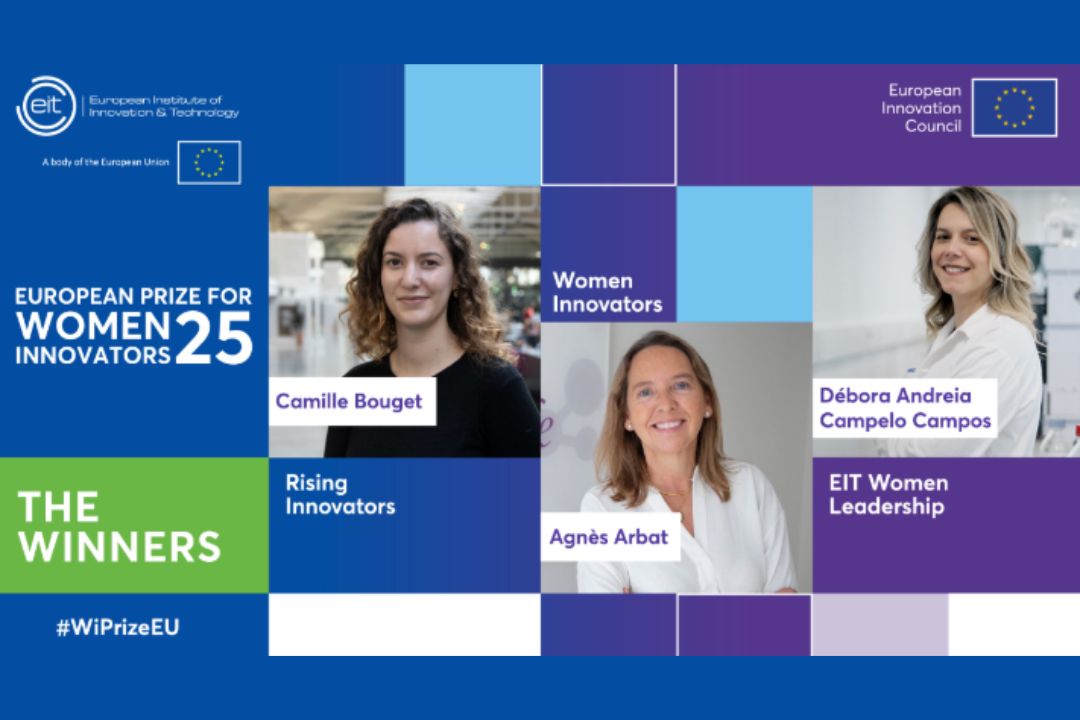15th July 2019
EIT Health Innovation Project also spawns Campus activities and design-thinking workshop
Closing the loop can dramatically improve quality of life for many chronic patients on insulin therapy. The CLOSE project has taken a cross-pillar approach to this challenge, stimulating initiatives around the innovation triangle while producing its own solution for closed-loop metabolic control.
What began as an EIT Health Innovation Project also spawned a consortium of active partners, a two-part Campus Summer School, a thematic study by Campus students and a design-thinking workshop.
The CLOSE EIT Health Inovation Project by Design deploys an integrated homecare solution (AP+) centred around closed-loop metabolic control for people with chronic conditions.

AP+ consists of an Artificial Pancreas (AP), telemedical services, training, and indicators measuring AP+ impact on health while identifying most AP+-sensitive patients. CLOSE responds to a critical and cost intensive health issue that affects millions of patients and their loved ones.

Professor Dr Freimut Schliess (pictured at left) is the Director of Science & Innovation at Profil Germany – a globally operating full service Contract Research Organisation uniquely positioned by its focus on clinical trials evaluating drugs and devices for people living with diabetes.
The company has been involved in developing nearly all major anti-diabetic compounds and devices in the market today.
Profil has in-depth experience in the development and clinical evaluation of closed-loop metabolic control systems, and it is the organisation coordinating the CLOSE Innovation Project. In this interview, Dr Schliess answers questions about the broad range of EIT Health cooperation encouraged by CLOSE.
Q: I understand that you are starting home trials of the CLOSE project’s Artificial Pancreas. What are the latest developments with that specific project?
Freimut Schliess: You refer to the “CLOSE Study”. This is a longitudinal non-interventional mono‐centric pilot study collaborating with type 2 diabetes patients on insulin pump therapy in France. This clinical trial collects glycaemic data under real-life conditions at home. The results of this study will allow us to further refine the appropriate group of patients most sensitive to AP treatment and directly feed into algorithm development. To integrate the field experience of prescribing physicians, the trial protocol has been developed in collaboration with globally acknowledged key opinion leaders in clinical diabetology.
Q: Can you explain the relationship between the CLOSE Innovation Project, the CDTM Trend Seminar, the InnoDiaCare Summer School and the Going AP+ Value Concept Design workshop?
FS: The three events mentioned by you materialise our conviction that a pro-active implementation of the EIT knowledge triangle, i.e. a full integration of market-oriented research, education, and business creation, will maximise the acceptance of AP+ from the side of different stakeholders, including patients and payers.
This is why we were happy to be selected by the Munich Center for Digital Technology and Management – the CDTM – to co-design a seven-week Trend Seminar on “Digital Innovation in Diabetes Care – Opportunities and Risks for Patients, Health Care, and Economies” in Autumn 2016. Here we met 26 fantastic students from different backgrounds. Some of them were already ready to contribute their own entrepreneurial experience. Based on present observations and reliable expectations for the near future, the students identified trends along different dimensions of individual and societal reality.
Then they used the trends to develop a space of equally plausible future scenarios, which again were used to explore the market opportunities of specific business ideas. The students have convincingly demonstrated that investments in diabetes prevention and management have the potential to unfold outstanding societal impact, even when assuming different and partly contradictory future scenarios. The outcome of the Trend Seminar is very relevant to the CLOSE project. The students developed some blueprints for expanding the CLOSE business model by functionally enhancing the AP to a device with multiple capabilities even beyond pure metabolic control.
The positive experience with the Trend Seminar encouraged the CLOSE partner Medical University of Lodz (InnoStars) to implement the InnoDiaCare EIT Health Summer School on Digital Innovation in Diabetes Care in collaboration with the University of Cologne. This two-part Summer School had a tremendous start in July 2017 in Lodz, and the students came out with impressive business proposals during their week in Cologne. Here the ambition of the CLOSE partnership is to scout fresh ideas and facilitate a sustainable follow-up of the students’ most excellent business ideas.
The “Going AP+ Value Concept Design Workshop“, developed by CLOSE partner IESE Business School, had a different format. During this two-day design-thinking workshop, a wide range of diabetes related professionals from very different disciplines from the CLOSE consortium, and some selected external key opinion leaders, joined forces to question, disrupt, and rethink the status quo of type 2 diabetes treatment. We gained a wide range of additional insights that will guide future work in the CLOSE project.
Q: How did the series of CLOSE initiatives get started? Did it all begin with the CLOSE Innovation Project? Are there other “spinoffs” from this project?
FS: A technical cure of type 1 diabetes by means of an AP has been under development for a number of years. The large European AP@home consortium, which was coordinated by Profil‘s co-founder Professor Dr Lutz Heinemann together with Dr Hans de Vries from the Academic Medical Centre Amstersdam, can be considered as the precursor to CLOSE. AP@home has prototyped AP systems for patients with type 1 diabetes. They have implemented multiple clinical trials evaluating the device in clinical research units and under real-life conditions at home. These trials have shown that AP systems work successfully in patients with type 1 diabetes. However, although AP studies in type 1 diabetes stirred great public enthusiasm, there are rather vague perspectives on liability and reimbursement. Among other reasons this is due to the fact that today’s insulin therapy regimens meet already high medical standards and can be well integrated into the everyday life of the many adults with type 1 diabetes who are otherwise healthy.
The development of the ClampArt® at Profil is another story with which CLOSE is connected. ClampArt® is a CE-marked semi closed-loop system for blood glucose clamping. The medical device is exclusively used in clinical trials for the glucodynamic characterisation of insulins and quantitative assessments of human metabolism. Of course, the technical and regulatory expertise from AP@home and ClampArt® immediately feeds into the CLOSE project and complements the many other capabilities made available by the CLOSE partnership.
As you can see, CLOSE is clearly not about inventing the AP. Rather CLOSE is a market implementation project using a French real-world scenario for demonstrating an effective AP operation under conditions of optimised risk-benefit and cost-benefit balances. This is also the rationale behind our decision to initially focus on patients with type 2 diabetes with co-morbid conditions. These patients are particularly vulnerable to deteriorations in glycaemic control, and that can trigger a downward spiral to further health loss, dependency and hospitalizations. This cohort requires multiple caregiver interactions to administer standard insulin treatments every day.
Therefore, integrating an AP system into type 2 diabetes care will relieve patients, nursing relatives and ambulatory health care professionals from time-consuming and error-prone blood glucose assessments and insulin dosing. In view of the large number of patients with type 2 diabetes, CLOSE sees an outstanding potential for AP+ scalability in terms of geography, target group, function, and care environment.
Q: What is the CLOSE consortium, and how does it work?
FS: For one thing, CLOSE is a four-year EIT Health Innovation Project designed in response to the EIT Health Call for Innovation Proposals in 2015. Our proposal achieved an excellent rating – most recently as a result of an EIT onsite monitoring in June 2017 – which led to the integration of CLOSE into the EIT Health Business Plans 2016, 2017 and 2018.
CLOSE is also the organisations and the people who execute the project. In our partnership we combine the power of two large corporations with the agility of smaller companies, the research and education capabilities of two universities, and the strategic intelligence of a business school. CLOSE integrates partners with highly complementary capabilities from the French, German, Spanish and Belgium/Netherlands Co-Location Centres, as well as from the InnoStars.
Even before the official project start, we have implemented clear structures of governance, responsibilities, and reporting. Profil has been getting support from the European Research and Project Office (EURICE) GmbH since the initial proposal-writing phase. Today, EURICE provides CLOSE coordination support in IP management, mediation of potential conflicts and contracting. The collaboration guarantees a high effectiveness and efficiency in managing the consortium – even in phases with a high administrative burden.
The uniqueness of CLOSE is given by the integration of a healthcare provider with strong experience in the provision of infusion therapies for chronic diseases, including diabetes. This enables us to benefit from established best practices of building the connections between patients, health professionals, payers and prescribers. Today our industry partners consider CLOSE a key project for establishing a strategic collaboration and new innovation pathways in the area of diabetes care.
Q: One project keeps generating new initiatives aimed at addressing diabetes. How do you get others involved, and what encouraged this approach?
FS: CLOSE is a living organisation, very open to the integration of new partners based on strategic fit and willingness to invest own co-funding. We already collaborate with organisations from outside EIT Health that ideally complement the capabilities of the EIT Health members. In 2017 we have intensified our collaboration with patients, payers, nurses and physicians. Here we benefit from excellent networking within and beyond EIT Health, and decades of presence in global diabetes care markets.
We also support other EIT Health partners to develop projects that are complementary with CLOSE and could help to generate synergies in impacting chronic care in Europe. Here we are very much looking forward to collaborating with the Innovation Projects participating in the EIT Health Business Plan 2018.
Q: How does the existence of EIT Health facilitate cooperation for healthcare innovations?
FS: In my view the EIT Health community provides outstanding opportunities for networking and the establishment of new collaboration schemes. CLOSE exemplifies a consortium that wouldn’t exist without EIT Health. We experience EIT Health as an enabling and risk mitigating environment, facilitating the marketing of breakthrough innovative solutions. The curation of the CLOSE project – which follows quality standards and an aligned strategy to deliver high impact as well as a lively feedback culture that add value to the project – goes far beyond the provision of EIT funding. I see tremendous opportunities for impact, by the development of outcome-oriented EIT Health support in business partnering, data access, regulatory affairs, stakeholder involvement, and business communication.
Q: What are the potential benefits of the EIT Health approach for improving diabetes care and addressing the needs of diabetes patients?
FS: Diabetes is the paradigm for rewarding innovation in the health sector. On the one hand, it is clear that diabetes accounts for considerable societal challenges. On the other, there is also good news: most pro-diabetic risk factors are highly modifiable, the disease may be potentially reversible, and there is an outstanding role of the patient’s self-responsibility in diabetes management. This creates a lot of room for patient-centred digital solutions impacting the life quality not only of the patients but also of their social environments. This matches exactly with the EIT Health Strategic Agenda. I am convinced that a chronic care-related EIT Health platform addressing the diabetes issue will be an outstanding opportunity to make a difference in the health of European citizens.
Q: Is there anything else you’d like to add?
FS: Yes – this is a good opportunity to thank Prof. Dr Lutz Heinemann, Dr Tim Heise, and Dr Carsten Benesch, Marc Lemaire (Air Liquide Healthcare), and Dr Volker Lodwig (Roche) for great discussions in the very early phase of CLOSE conception. Special heartfelt thanks go out to Sylvie Bove (CEO EIT Health) and her team and the people from the EIT Health Co-Location Centers for developing a fantastic knowledge and innovation environment very much supporting us in making CLOSE a success!
How 5 EIT Health start-ups are driving big data innovations in healthcare

Harnessing health data in Europe.
Celebrating EIT Health-supported innovators at the 2025 European Prize for Women Innovators

Congratulations to the winners.
Investing in children's health: The urgent need for paediatric innovation in Europe

Paediatric and maternal health innovation across Europe.